The AMD Ryzen 3 3300X and 3100 CPU Review: A Budget Gaming Bonanza
by Dr. Ian Cutress on May 7, 2020 9:00 AM ESTCPU Performance: System Tests
Our System Test section focuses significantly on real-world testing, user experience, with a slight nod to throughput. In this section we cover application loading time, image processing, simple scientific physics, emulation, neural simulation, optimized compute, and 3D model development, with a combination of readily available and custom software. For some of these tests, the bigger suites such as PCMark do cover them (we publish those values in our office section), although multiple perspectives is always beneficial. In all our tests we will explain in-depth what is being tested, and how we are testing.
All of our benchmark results can also be found in our benchmark engine, Bench.
Application Load: GIMP 2.10.4
One of the most important aspects about user experience and workflow is how fast does a system respond. A good test of this is to see how long it takes for an application to load. Most applications these days, when on an SSD, load fairly instantly, however some office tools require asset pre-loading before being available. Most operating systems employ caching as well, so when certain software is loaded repeatedly (web browser, office tools), then can be initialized much quicker.
In our last suite, we tested how long it took to load a large PDF in Adobe Acrobat. Unfortunately this test was a nightmare to program for, and didn’t transfer over to Win10 RS3 easily. In the meantime we discovered an application that can automate this test, and we put it up against GIMP, a popular free open-source online photo editing tool, and the major alternative to Adobe Photoshop. We set it to load a large 50MB design template, and perform the load 10 times with 10 seconds in-between each. Due to caching, the first 3-5 results are often slower than the rest, and time to cache can be inconsistent, we take the average of the last five results to show CPU processing on cached loading.
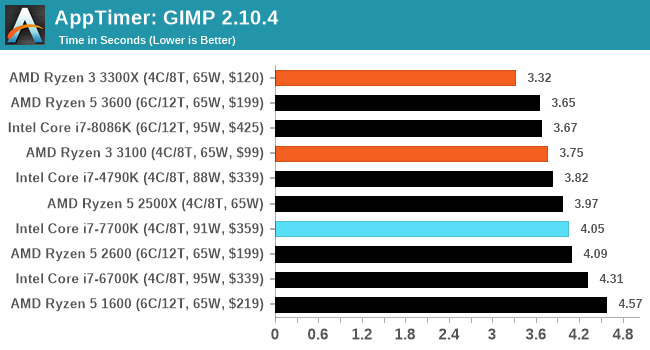
3D Particle Movement v2.1: Brownian Motion
Our 3DPM test is a custom built benchmark designed to simulate six different particle movement algorithms of points in a 3D space. The algorithms were developed as part of my PhD., and while ultimately perform best on a GPU, provide a good idea on how instruction streams are interpreted by different microarchitectures.
A key part of the algorithms is the random number generation – we use relatively fast generation which ends up implementing dependency chains in the code. The upgrade over the naïve first version of this code solved for false sharing in the caches, a major bottleneck. We are also looking at AVX2 and AVX512 versions of this benchmark for future reviews.
For this test, we run a stock particle set over the six algorithms for 20 seconds apiece, with 10 second pauses, and report the total rate of particle movement, in millions of operations (movements) per second. We have a non-AVX version and an AVX version, with the latter implementing AVX512 and AVX2 where possible.
3DPM v2.1 can be downloaded from our server: 3DPMv2.1.rar (13.0 MB)
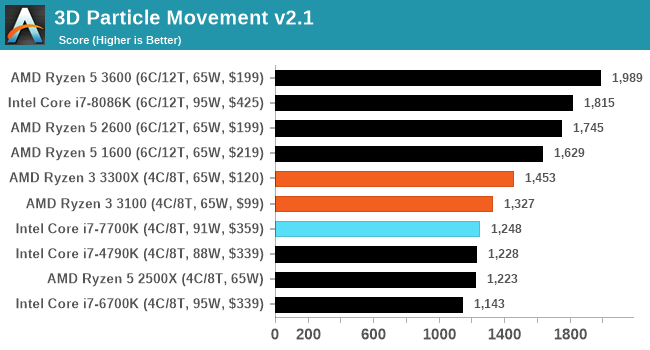
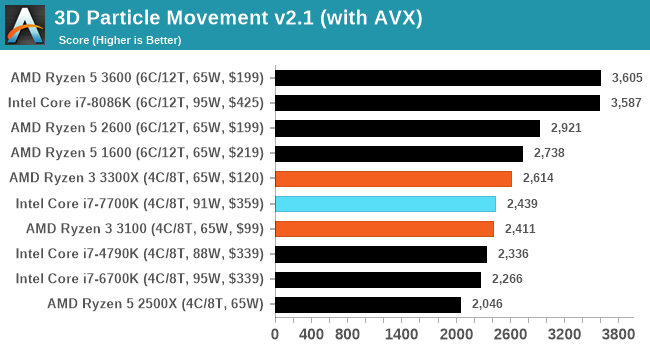
Dolphin 5.0: Console Emulation
One of the popular requested tests in our suite is to do with console emulation. Being able to pick up a game from an older system and run it as expected depends on the overhead of the emulator: it takes a significantly more powerful x86 system to be able to accurately emulate an older non-x86 console, especially if code for that console was made to abuse certain physical bugs in the hardware.
For our test, we use the popular Dolphin emulation software, and run a compute project through it to determine how close to a standard console system our processors can emulate. In this test, a Nintendo Wii would take around 1050 seconds.
The latest version of Dolphin can be downloaded from https://dolphin-emu.org/
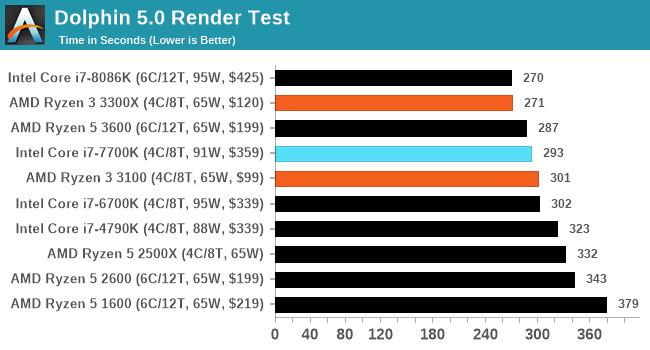
DigiCortex 1.20: Sea Slug Brain Simulation
This benchmark was originally designed for simulation and visualization of neuron and synapse activity, as is commonly found in the brain. The software comes with a variety of benchmark modes, and we take the small benchmark which runs a 32k neuron / 1.8B synapse simulation, equivalent to a Sea Slug.
Example of a 2.1B neuron simulation
We report the results as the ability to simulate the data as a fraction of real-time, so anything above a ‘one’ is suitable for real-time work. Out of the two modes, a ‘non-firing’ mode which is DRAM heavy and a ‘firing’ mode which has CPU work, we choose the latter. Despite this, the benchmark is still affected by DRAM speed a fair amount.
DigiCortex can be downloaded from http://www.digicortex.net/
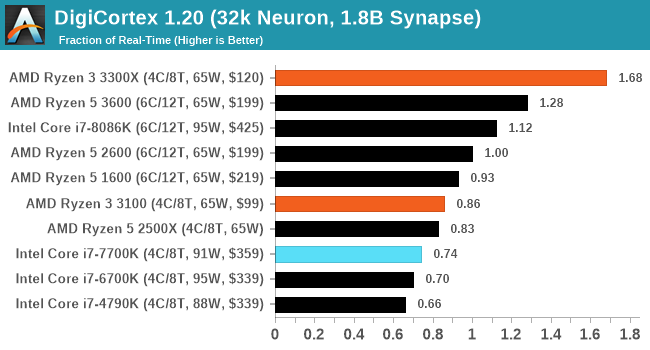
y-Cruncher v0.7.6: Microarchitecture Optimized Compute
I’ve known about y-Cruncher for a while, as a tool to help compute various mathematical constants, but it wasn’t until I began talking with its developer, Alex Yee, a researcher from NWU and now software optimization developer, that I realized that he has optimized the software like crazy to get the best performance. Naturally, any simulation that can take 20+ days can benefit from a 1% performance increase! Alex started y-cruncher as a high-school project, but it is now at a state where Alex is keeping it up to date to take advantage of the latest instruction sets before they are even made available in hardware.
For our test we run y-cruncher v0.7.6 through all the different optimized variants of the binary, single threaded and multi-threaded, including the AVX-512 optimized binaries. The test is to calculate 250m digits of Pi, and we use the single threaded and multi-threaded versions of this test.
Users can download y-cruncher from Alex’s website: http://www.numberworld.org/y-cruncher/
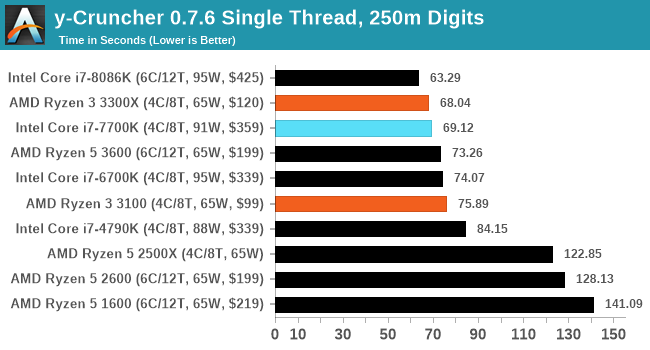
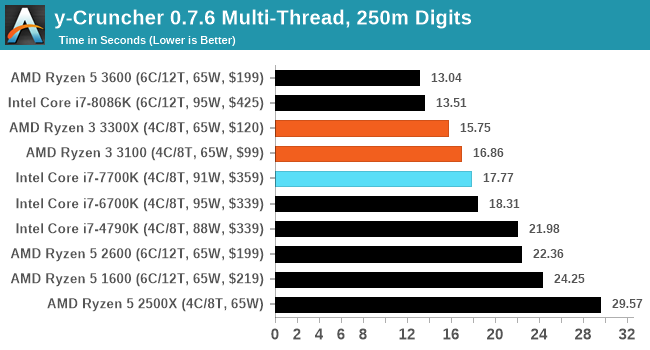
Agisoft Photoscan 1.3.3: 2D Image to 3D Model Conversion
One of the ISVs that we have worked with for a number of years is Agisoft, who develop software called PhotoScan that transforms a number of 2D images into a 3D model. This is an important tool in model development and archiving, and relies on a number of single threaded and multi-threaded algorithms to go from one side of the computation to the other.
In our test, we take v1.3.3 of the software with a good sized data set of 84 x 18 megapixel photos and push it through a reasonably fast variant of the algorithms, but is still more stringent than our 2017 test. We report the total time to complete the process.
Agisoft’s Photoscan website can be found here: http://www.agisoft.com/













249 Comments
View All Comments
Ian Cutress - Thursday, May 7, 2020 - link
Unfortunately, we never got any of those. I'm recently stretched six ways from Sunday. Pulled an all-nighter just to even get to this point in the review process. As much as people would love me just to bench CPUs all day every day, even in lockdown I've got these CPUs, EPYC, Motherboards, Xeons, laptops to test, as well as news coverage and all the behind the scenes stuff no-one ever sees. Writing isn't a quick process, either.destorofall - Thursday, May 7, 2020 - link
Surely Ian you can just use the AI wirter now :)Lord of the Bored - Thursday, May 7, 2020 - link
The AI Writer read the comments and now just fanboy-flames.eastcoast_pete - Thursday, May 7, 2020 - link
Appreciate the reply! I think the fact that you never got those current-gen i3s and i5s is not on you, but on Intel. If they want their stuff reviewed, they know they need to send some samples. Unless, of course, they're afraid of the test results. Which they might just be.Namisecond - Thursday, May 7, 2020 - link
I just noticed in the "AMD 500 SERIES CHIPSET PROCESSOR SUPPORT" chart; 4000 series/Zen2 based desktop APUs are not represented. An oversight? or is AMD trying to say something?qwertymac93 - Thursday, May 7, 2020 - link
There's got to be something strange going on with the 7700k system. In several benchmarks the 6700k outperforms the 7700k, even though the only difference between them is the 7700k is clocked higher. Under no circumstances should the 6700k outperform the 7700k.Were the Skylake and Kaby lake systems tested with different motherboards or with different BIOS revisions? Its possible some security patch was active on one system but not on another.
EdgeOfDetroit - Thursday, May 7, 2020 - link
You should have benched it against a Xeon E-2174G. At least that's the most modern 4C8T CPU Intel sells right now. But I look forward to seeing how it does against the i3-i3-10320 to see if Intel still has the IPC-clockspeed crown or not.schujj07 - Friday, May 8, 2020 - link
The performance of the i3-10320 will be very similar to the 7700k. The i3 has clock speeds of 3.8/4.6 and the 7700k is 4.2/4.5. That means that on single threaded the 10320 will be slightly faster but in heavily threaded work loads the 7700k will probably be faster due to the higher base clock. This is know because both CPUs are on the Sky Lake architecture and will have the same IPC. Therefore we can infer what the 10320 will do based on what we see the 7700k doing in this review.Sushisamurai - Thursday, May 7, 2020 - link
I think it'd be nice to see generational to generational improvements on intel vs AMD's side of things, you guys use to do that everytime a new generation came out. It'd be nice to see how far my 4th gen Intel chip has gone vs a new gen now.Maxiking - Thursday, May 7, 2020 - link
Again your garbage reviews. Apparently all the cpus on the world are bottlenecking 1080 gtx @ 1080p except 3300x.Do you even think when checking the results. This thing happens constantly, especially when you test low end garbage amd cpus.